Crystals from the Powellite-Scheelite Series at the Nanoscale: A Case Study from the Zhibula Cu Skarn, Gangdese Belt, Tibet
Abstract
:1. Introduction
2. Zhibula Cu Skarn
3. Sample and Methodology
4. Results
4.1. Sample Petrography
4.2. Compositional Data: Major and Trace Elements
4.3. Nanoscale Characterisation of Scheelite-Powellite Grains
5. Discussion
5.1. Solid Solution in the Scheelite-Powellite Series: Evidence from Zhibula
5.2. Formation Conditions and Evolutionary Model
6. Conclusions
- A wide range of compositions within the scheelite-powellite solid solution series, from 20 mol.% to 80 mol.% Pow, occur as patterned, oscillatory-zoned single crystals and sliver domains, in a matrix of unzoned/weakly zoned, close-to-end-member scheelite (87 mol.%–95 mol.% Sch) in the Zhibula skarnoid (prograde grossular50–diopside80–anorthite with retrograde clinozoisite). Molybdenite is present on the margins of the Sch-Pow aggregates. Compositional data and element mapping at the µm-scale reveal systematic partitioning behaviour of trace elements in skarn minerals and scheelite-powellite aggregates. The Mo-rich domains positively correlate with higher concentrations of As, Nb, and LREE, whereas W-rich domains are relatively enriched in Y and Sr.
- Electron diffractions, HAADF STEM imaging, and EDS STEM mapping of thinned foils prepared from the two main types of patterns show chemical oscillatory zoning with interfaces that have continuity in crystal orientation throughout each defined structure, zoned grain or sliver. In contrast, the interfaces with a sharp chemical difference (sliver to matrix), show rotation of {011} lattice vectors differing from the continuity in orientation at interfaces of low chemical difference (zoned grain and embedding domain). Atomic-scale resolution imaging and STEM simulation confirm scheelite-powellite within the analysed range (20 mol.% to 80 mol.% Pow). No discrete Mo- or W-bearing inclusions are observed, which might contribute to this compositional variation.
- The non-linear thermodynamics governing the patterning in non-ideal solid solution may account for the formation of distinct patterning domains within the Mo-rich areas of the scheelite-powellite aggregates, of which the sharpest contrast in chemical composition is also recognisable by variation in the growth directions.
- Nanoscale inclusions of xenotime-(Y) with epitaxial orientation to the host scheelite-powellite matrix are observed in both cases. This observation carries implications for the overall REE content of the host phase and, implicitly, for the use of REE concentrations and fractionation patterns for petrogenetic interpretation.
- A genetic model that accounts for observed geochemical and petrographic features involves deposition of a scheelite + molybdenite assemblage during the more reduced, prograde skarn stage followed by an oxidised, retrograde stage leading to the Mo-rich patterned domains within scheelite. During this stage, the lower-T oxidising (?) fluids can dissolve molybdenite and reprecipitate Mo as powellite-rich domains. The slight enrichment of LREE in the Mo-rich domains relative to W-rich domains is concordant with formation of nanoscale inclusions of xenotime-(Y), as well as Y-enrichment on the margins of scheelite, indicating that HREE are not soluble in lower T, retrograde fluids.
- This research demonstrates the utility of the HAADF-STEM technique on foils extracted in situ from a sample that has been texturally and compositionally well-characterised to address issues of solid solution and compositional heterogeneity. Such an approach has potential broad application for understanding analogous mineral series and constraining processes of ore genesis.
Supplementary Materials
Author Contributions
Funding
Acknowledgments
Conflicts of Interest
References
- Hsu, L.C.; Galli, P.E. Origin of the Scheelite-Powellite Series of Minerals. Econ. Geol. 1973, 68, 681–696. [Google Scholar] [CrossRef]
- Hazen, R.M.; Finger, L.W.; Mariathasan, J.W.E. High-pressure crystal chemistry of scheelite-type tungstates and molybdates. J. Phys. Chem. Solids 1985, 46, 253–263. [Google Scholar] [CrossRef]
- Tyson, R.M.; Hemphill, W.R.; Theisen, A.F. Effect of the W:Mo ratio on the shift of excitation and emission spectra in the scheelite-powellite series. Am. Miner. 1988, 73, 1145–1154. [Google Scholar]
- Fernandez-González, Á.; Andara, Á.; Prieto, M. Mixing properties and crystallization behaviour of the scheelite-powellite solid solution. Cryst. Growth Des. 2007, 7, 545–552. [Google Scholar] [CrossRef]
- Song, G.X.; Qin, K.Z.; Li, G.M.; Evans, N.J.; Chen, L. Scheelite elemental and isotopic signatures: Implications for the genesis of skarn-type W-Mo deposits in the Chizhou Area, Anhui Province, Eastern China. Am. Miner. 2014, 99, 303–317. [Google Scholar] [CrossRef]
- Hsu, L.C. Effects of oxygen and sulfur fugacities on the scheelite-tungstenite and powellite-molybdenite stability relations. Econ. Geol. 1977, 72, 664–670. [Google Scholar] [CrossRef]
- Förster, H.J.; Hunger, H.J.; Grimm, L. Elektronenstrahlmikroanalytische Untersuchungen von Erzmineralen aus der Zinn-Lagerstatte Altenberg (Erzgebirge, DDR). 3. Mitteilung: Die Scheelit-Powellit-Mischkristallreihe. Chem. Der Erde Geochem. 1987, 46, 321–328. [Google Scholar]
- Brugger, J.; Gieré, R.; Grobéty, B.; Uspensky, E. Scheelite-powellite and paraniite-(Y) from the Fe-Mn deposit at Fianel, Eastern Swiss Alps. Am. Miner. 1998, 83, 1100–1110. [Google Scholar] [CrossRef]
- Kwak, T.A.P.; Tan, T.H. The geochemistry of zoning in skarn minerals at the King Island (Dolphin) mine. Econ. Geol. 1981, 76, 468–497. [Google Scholar] [CrossRef]
- Zaw, K.; Singoyi, B. Formation of magnetite-scheelite skarn mineralization at Kara, Northwestern Tasmania: Evidence from mineral chemistry and stable isotopes. Econ. Geol. 2000, 95, 1215–1230. [Google Scholar] [CrossRef]
- Brugger, J.; Lahaye, Y.; Costa, S.; Lambert, D.; Bateman, R. Inhomogeneous distribution of REE in scheelite and dynamics of Archean hydrothermal systems (Mt. Charlotte and Drysdale gold deposits, Western Australia). Contrib. Min. Pet. 2000, 139, 251–264. [Google Scholar]
- Brugger, J.; Etschmann, B.; Pownceby, M.; Liu, W.; Grundler, P.; Brewe, D. Oxidation state of europium in scheelite: Tracking fluid-rock interaction in gold deposits. Chem. Geol. 2008, 257, 26–33. [Google Scholar] [CrossRef]
- Ghaderi, M.; Palin, J.M.; Campbell, I.H.; Sylvester, P.J. Rare earth element systematics in scheelite from hydrothermal gold deposits in the Kalgoorlie-Norseman region, Western Australia. Econ. Geol. 1999, 94, 423–437. [Google Scholar] [CrossRef]
- Dostal, J.; Kontak, D.J.; Chatterjee, A. Trace element geochemistry of scheelite and rutile from metaturbidite-hosted quartz vein gold deposits, Meguma Terrane, Nova Scotia, Canada: Genetic implications. Miner. Pet. 2009, 97, 95–109. [Google Scholar] [CrossRef]
- Poulin, R.S.; Kontak, D.J.; McDonald, A.M.; McClenaghan, B.M. Assessing Scheelite As an Ore-deposit Discriminator Using Its Trace-element REE Chemistry. Can. Miner. 2018, 56, 265–302. [Google Scholar] [CrossRef]
- Ciobanu, C.L.; Cook, N.J.; Maunders, C.; Wade, B.P.; Ehrig, K. Focused Ion Beam and Advanced Electron Microscopy for Minerals: Insights and Outlook from Bismuth Sulphosalts. Minerals 2016, 6, 112. [Google Scholar] [CrossRef]
- Cook, N.J.; Ciobanu, C.L.; George, L.; Zhu, Z.-Y.; Wade, B.; Ehrig, K. Trace Element Analysis of Minerals in Magmatic-Hydrothermal Ores by Laser Ablation Inductively-Coupled Plasma Mass Spectrometry: Approaches and Opportunities. Minerals 2016, 6, 111. [Google Scholar] [CrossRef]
- Cook, N.J.; Ciobanu, C.L.; Ehrig, K.; Slattery, A.; Verdugo-Ihl, M.R.; Courtney-Davies, L.; Gao, W. Advances and Opportunities in Ore Mineralogy. Minerals 2017, 7, 233. [Google Scholar] [CrossRef]
- Keyser, W.; Ciobanu, C.L.; Cook, N.J.; Feltus, H.; Johnson, G.; Slattery, A.; Wade, B.P.; Ehrig, K. Mineralogy of Zirconium in Iron-Oxides: A Micron- to Nanoscale Study of Hematite Ore from Peculiar Knob, South Australia. Minerals 2019, 9, 244. [Google Scholar] [CrossRef]
- Xu, J.; Zheng, Y.Y.; Sun, X.; Shen, Y.H. Geochronology and petrogenesis of Miocene granitic intrusions related to the Zhibula Cu skarn deposit in the Gangdese belt, southern Tibet. J. Asian Earth Sci. 2016, 120, 100–116. [Google Scholar] [CrossRef]
- Xu, J.; Zheng, Y.Y.; Sun, X.; Shen, Y.H. Alteration and mineralization at the Zhibula Cu skarn deposit, Gangdese belt, Tibet. Ore Geol. Rev. 2016, 75, 304–326. [Google Scholar] [CrossRef]
- Xu, J.; Ciobanu, C.L.; Cook, N.J.; Zheng, Y.; Sun, X.; Wade, B.P. Skarn formation and trace elements in garnet and associated minerals from Zhibula copper deposit, Gangdese Belt, southern Tibet. Lithos 2016, 262, 213–231. [Google Scholar] [CrossRef]
- Hou, Z.Q.; Cook, N.J. Metallogenesis of the Tibetan collisional orogen: A review and introduction to the special issue. Ore Geol. Rev. 2009, 36, 2–24. [Google Scholar] [CrossRef]
- Li, G.M.; Rui, Z.Y.; Wang, G.M.; Lin, F.C.; Liu, B.; She, H.Q.; Feng, C.Y.; Qu, W.J. Molybdenite Re–Os dating of Jiama and Zhibula polymetallic copper deposits in Gangdese metallogenic belt of Tibet and its significance. Miner. Depos. 2005, 24, 481–489, (in Chinese with English abstract). [Google Scholar]
- Jochum, K.P.; Weis, U.; Stoll, B.; Kuzmin, D.; Yang, Q.; Raczek, I.; Jacob, D.E.; Stracke, A.; Gunther, D.; Enzweiler, J. Determination of reference values for NIST SRM 610-617 glasses following ISO guidelines. Geostand. Geoanal. Res. 2011, 35, 397–429. [Google Scholar] [CrossRef]
- Guillong, M.; Hametner, K.; Reusser, E.; Wilson, S.A.; Günther, D. Preliminary characteristics of new glass reference materials (GSA-1G, GSC-1G, GSD-1G and GSE-1G) by laser ablation-inductively coupled plasma-mass spectrometry using 193 nm, 213 nm and 266 nm wavelengths. Geostand. Geoanal. Res. 2005, 29, 315–331. [Google Scholar] [CrossRef]
- Van Achterbergh, E.; Ryan, C.G.; Jackson, S.E.; Griffin, W.L. Data Reduction Software for LA-ICP-MS. In Laser-ablation-ICPMS in the Earth Sciences: Principles and Applications; Sylvester, P.J., Ed.; Mineral. Assoc.: Quebec City, QC, Canada, 2001; pp. 239–243. [Google Scholar]
- Woodhead, J.D.; Hellstrom, J.; Paton, C.; Hergt, J.M.; Greig, A.; Maas, R. A Guide to Depth Profiling and Imaging Applications of LA-ICM-PS. In Laser Ablation ICPMS in the Earth Sciences: Current Practices and Outstanding Issues; Mineralogical Association of Canada, Short Course Series 40; Sylvester, P.J., Ed.; Mineralogical Association of Canada: Quebec City, QC, Canada, 2008; pp. 135–145. [Google Scholar]
- Ciobanu, C.L.; Cook, N.J.; Utsunomiya, S.; Pring, A.; Green, L. Focussed ion beam—transmission electron microscopy applications in ore mineralogy: Bridging micron- and nanoscale observations. Ore Geol. Rev. 2011, 42, 6–31. [Google Scholar] [CrossRef]
- Orhan, A. Evolution of the Mo-rich scheelite skarn mineralization at Kozbudaklar, Western Anatolia, Turkey: Evidence from mineral chemistry and fluid inclusions. Ore Geol. Rev. 2017, 80, 141–165. [Google Scholar] [CrossRef]
- Song, S.W.; Mao, J.W.; Xie, G.Q.; Yao, Z.; Chen, G.; Rao, J. The formation of the world-class Zhuxi scheelite skarn deposit: Implications from the petrogenesis of scheelite-bearing anorthosite. Lithos 2018, 312–313, 153–170. [Google Scholar] [CrossRef]
- Sun, K.K.; Chen, B. Trace elements and Sr-Nd isotopes of scheelite: Implications for the W-Cu-Mo polymetallic mineralization of the Shimensi deposit, South China. Amer. Miner. 2017, 102, 1114–1128. [Google Scholar]
- Battey, M.H.; Moss, A.A. Powellite from Traprain Law, Haddingtonshire, Scotland. Miner. Mag. 1962, 33, 158–161. [Google Scholar] [CrossRef]
- Ni, Y.; Hughes, J.M.; Mariano, A.N. Crystal chemistry of the monazite and xenotime structures. Am. Miner. 1995, 80, 21–26. [Google Scholar] [CrossRef]
- Ding, T.; Ma, D.; Lu, J.; Zhang, R. Garnet and scheelite as indicators of multi-stage tungsten mineralization in the Huangshaping deposit, southern Hunan province, China. Ore Geol. Rev. 2018, 94, 193–211. [Google Scholar] [CrossRef]
- Gaspar, M.; Knaack, C.; Meinert, L.D.; Moretti, R. REE in skarn systems: A LA-ICP-MS study of garnets from the Crown Jewel gold deposit. Geochim. Cosmochim. Acta 2008, 72, 185–205. [Google Scholar] [CrossRef]
- Nadoll, P.; Angerer, T.; Mauk, J.L.; French, D.; Walshe, J. The chemistry of hydrothermal magnetite: A review. Ore Geol. Rev. 2014, 61, 1–32. [Google Scholar] [CrossRef]
- George, L.L.; Cook, N.J.; Ciobanu, C.L. Partitioning of trace elements in co-crystallized sphalerite–galena–chalcopyrite hydrothermal ores. Ore Geol. Rev. 2016, 77, 97–116. [Google Scholar] [CrossRef]
- Smith, M.; Henderson, P.; Jeffries, T.; Long, J.; Williams, C. The rare earth elements and uranium in garnets from the Beinn an Dubhaich Aureole, Skye, Scotland, UK: Constraints on processes in a dynamic hydrothermal system. J. Pet. 2004, 45, 457–484. [Google Scholar] [CrossRef]
- Ismail, R.; Ciobanu, C.L.; Cook, N.J.; Teale, G.S.; Giles, D.; Schmidt Mumm, A.; Wade, B. Rare earths and other trace elements in minerals from skarn assemblages, Hillside iron oxide–copper–gold deposit, Yorke Peninsula, South Australia. Lithos 2014, 184–187, 456–477. [Google Scholar] [CrossRef]
- Krneta, S.; Ciobanu, C.L.; Cook, N.J.; Ehrig, K.; Kontonikas-Charos, A. Rare earth element behaviour in apatite from the Olympic Dam Cu-U-Au-Ag deposit, South Australia. Minerals 2017, 7, 135. [Google Scholar] [CrossRef]
- Krneta, S.; Ciobanu, C.L.; Cook, N.J.; Ehrig, K.; Kontonikas-Charos, A. The Wirrda Well and Acropolis prospects Gawler Craton, South Australia: Insights into evolving fluid conditions through apatite chemistry. J. Geochem. Explor. 2017, 181, 276–291. [Google Scholar] [CrossRef]
- Zhao, W.W.; Zhou, M.F.; Williams-Jones, A.E. Constraints on the uptake of REE by scheelite in the Baoshan tungsten skarn deposit, South China. Chem. Geol. 2017, 477, 123–136. [Google Scholar] [CrossRef]
- Krneta, S.; Ciobanu, C.L.; Cook, N.J.; Ehrig, K.J. Numerical modelling of REE fractionation patterns in fluorapatite from the Olympic Dam deposit (South Australia). Minerals 2018, 8, 342. [Google Scholar] [CrossRef]
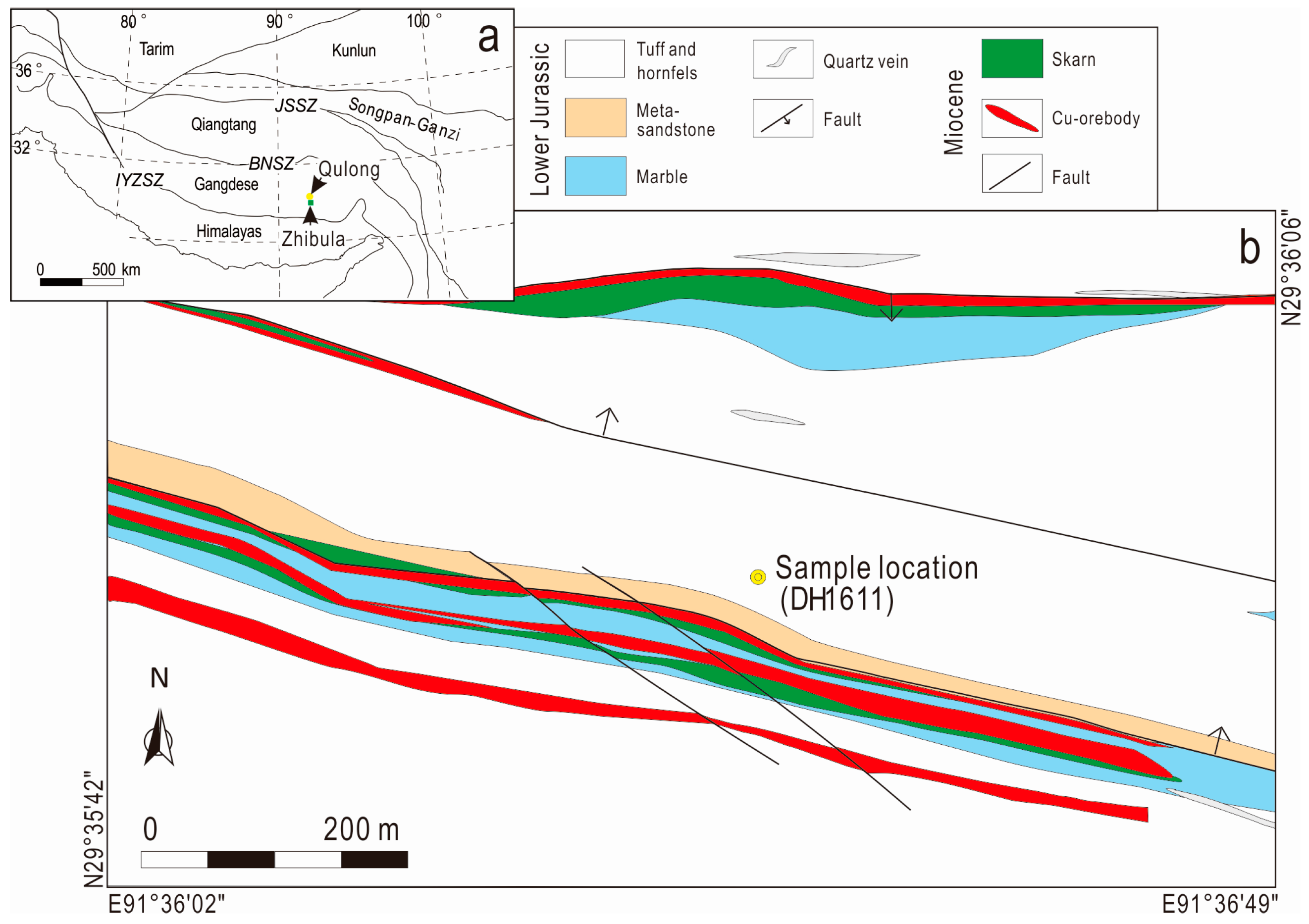

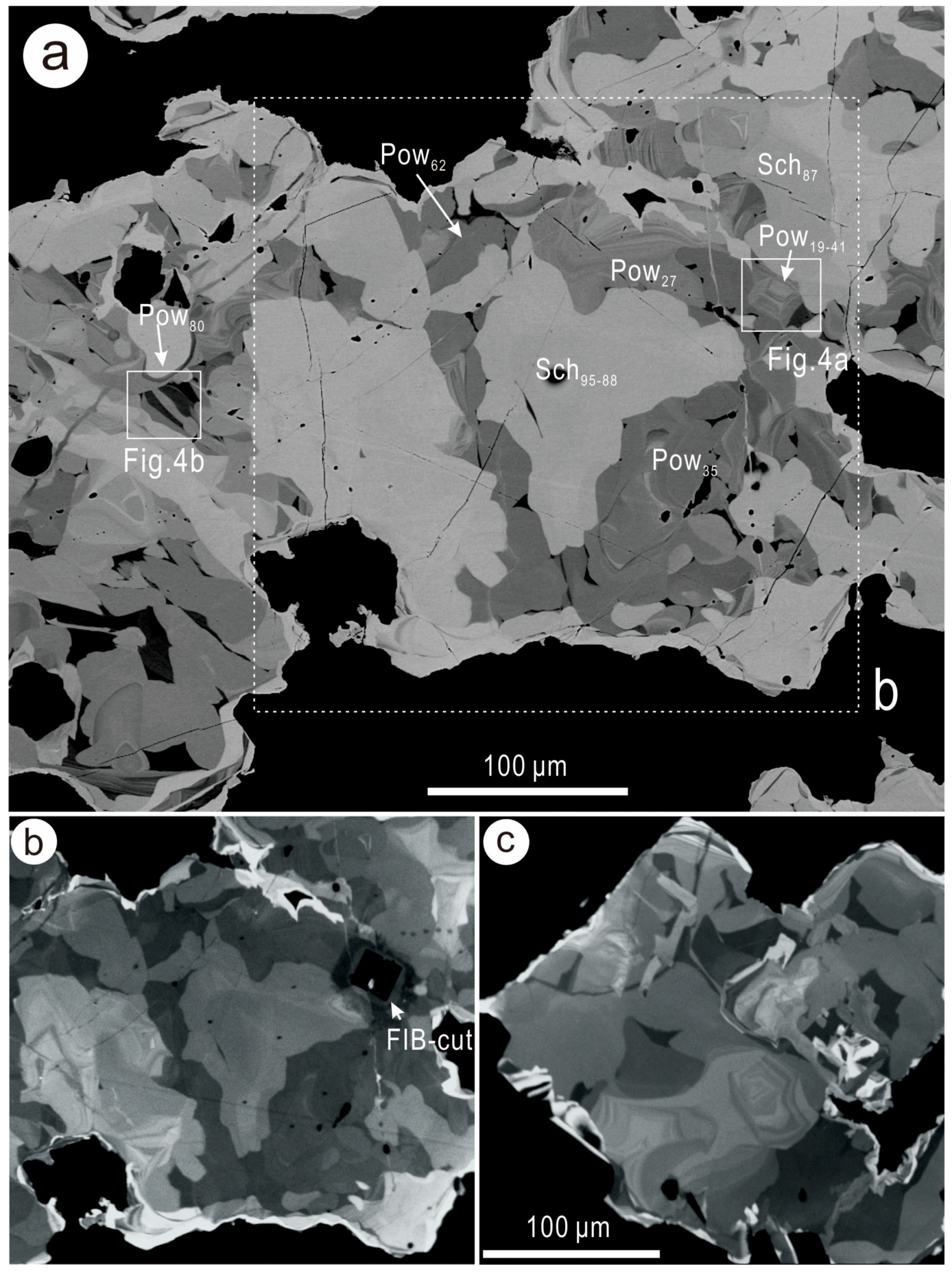
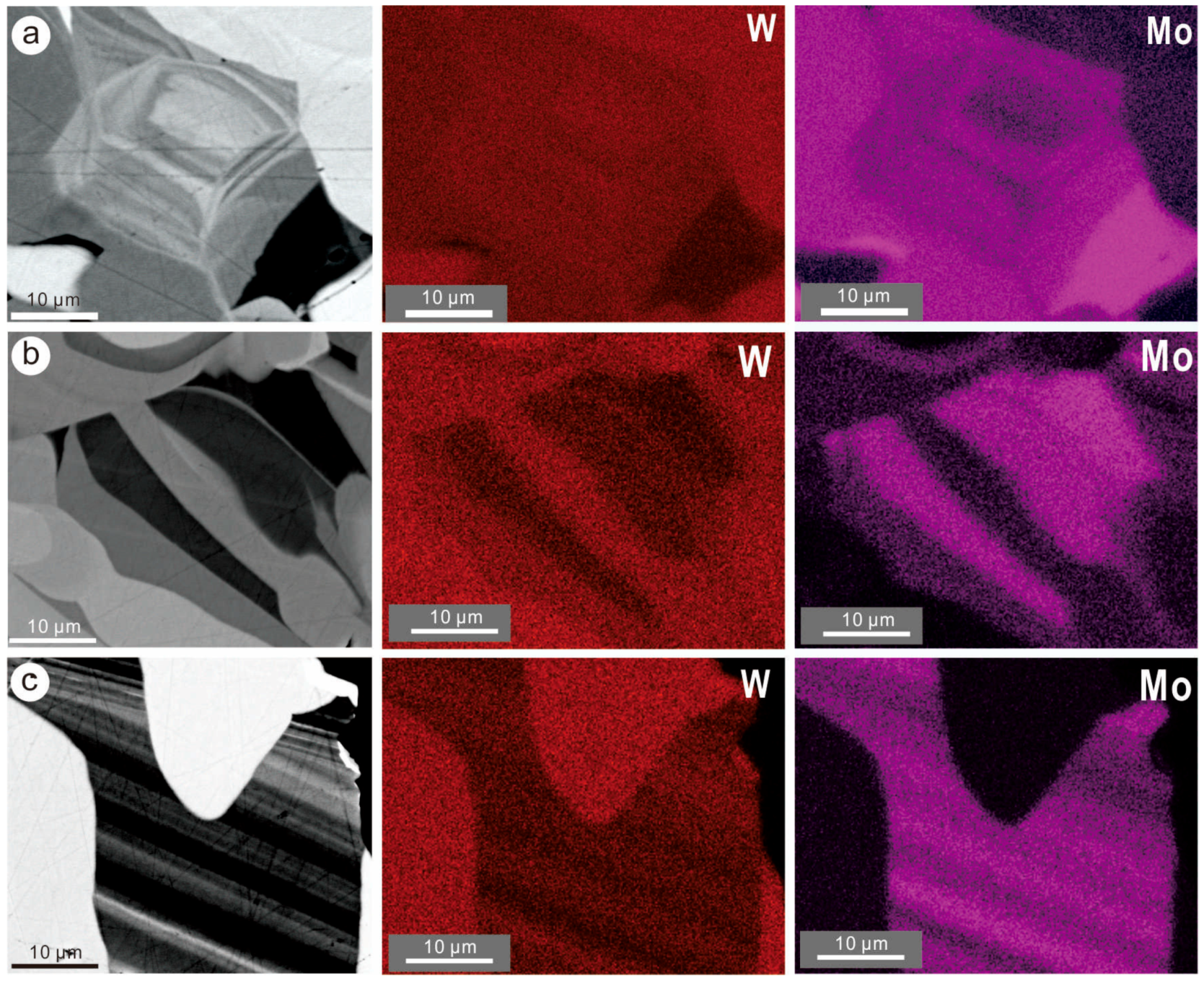



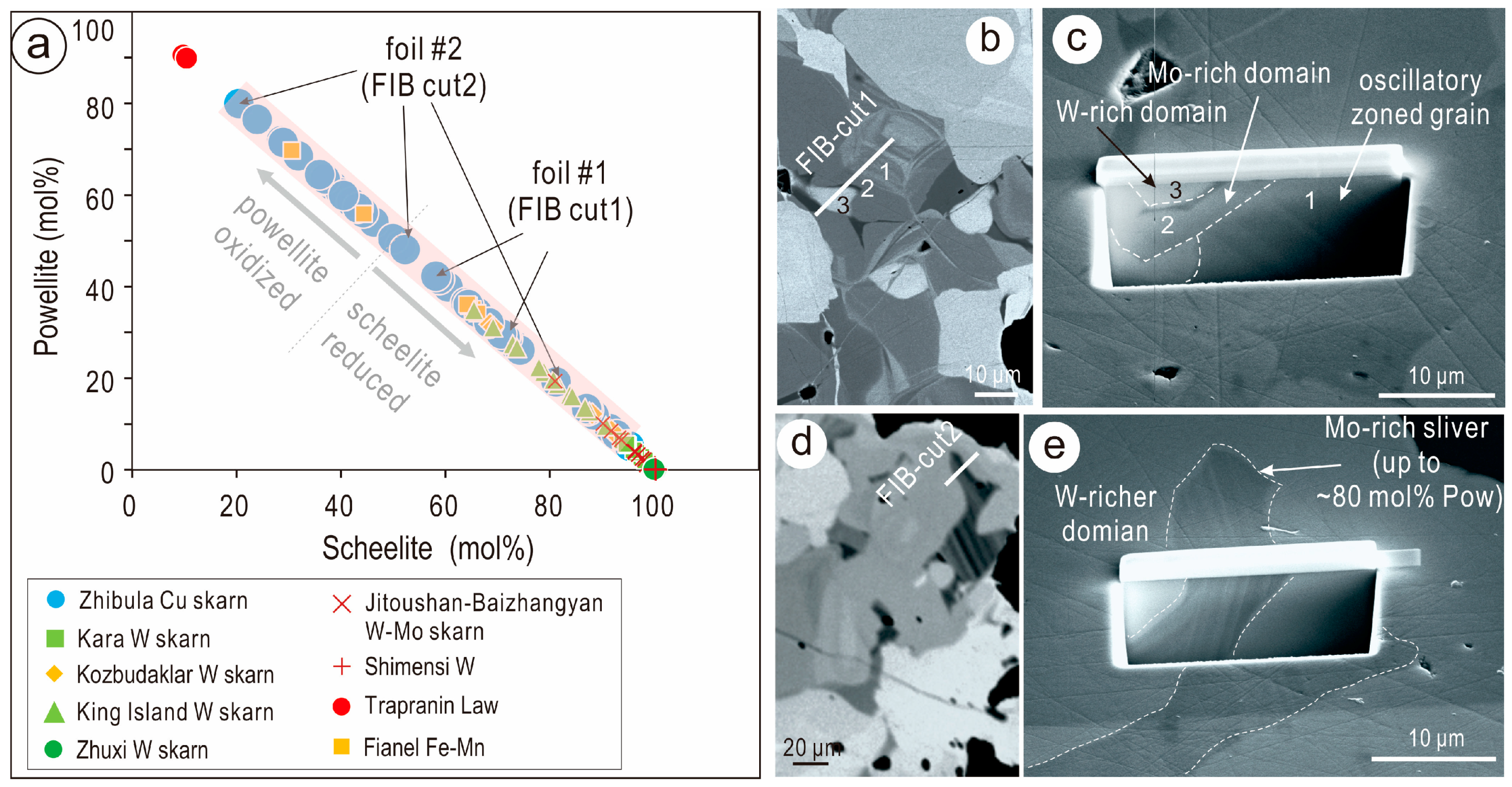


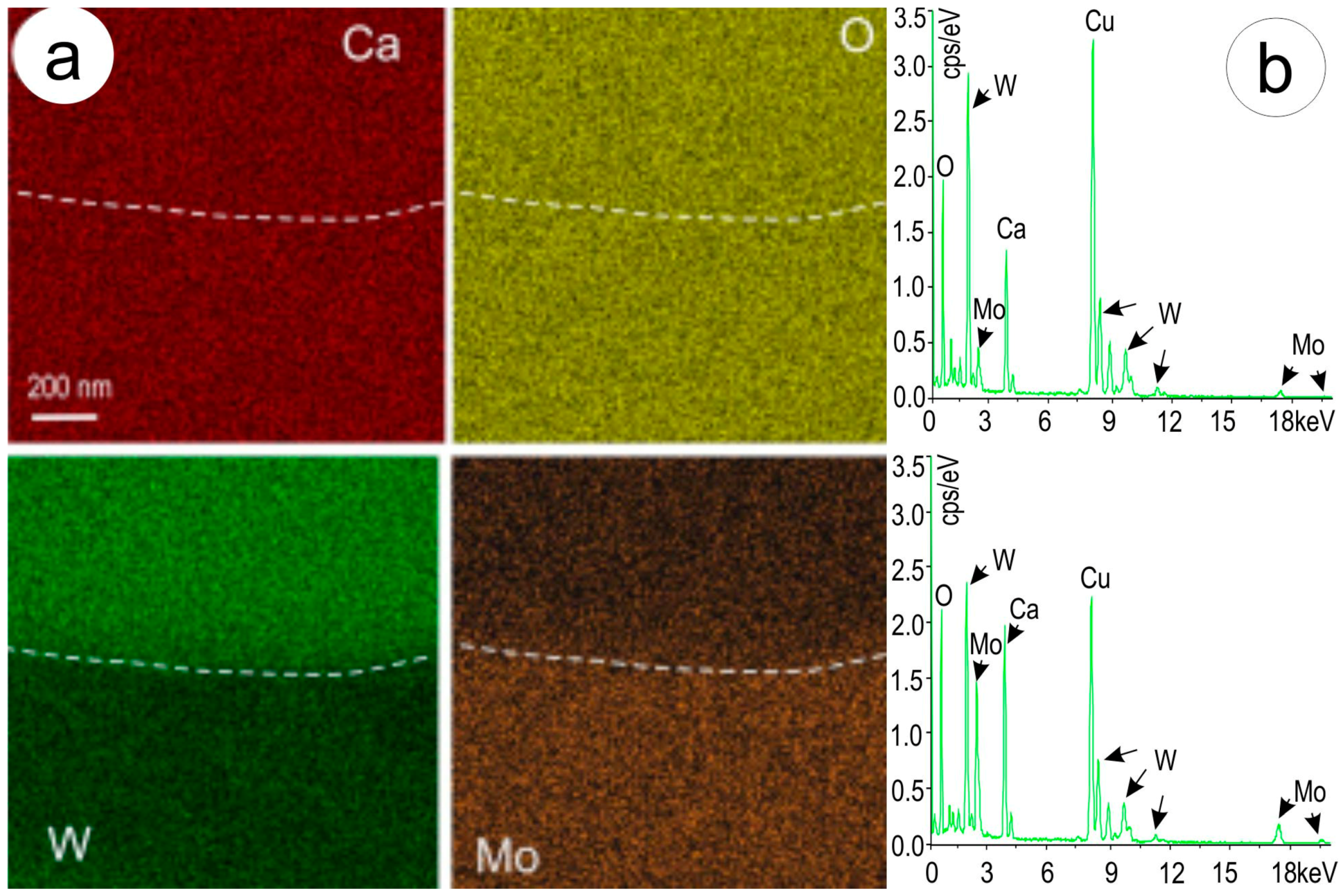



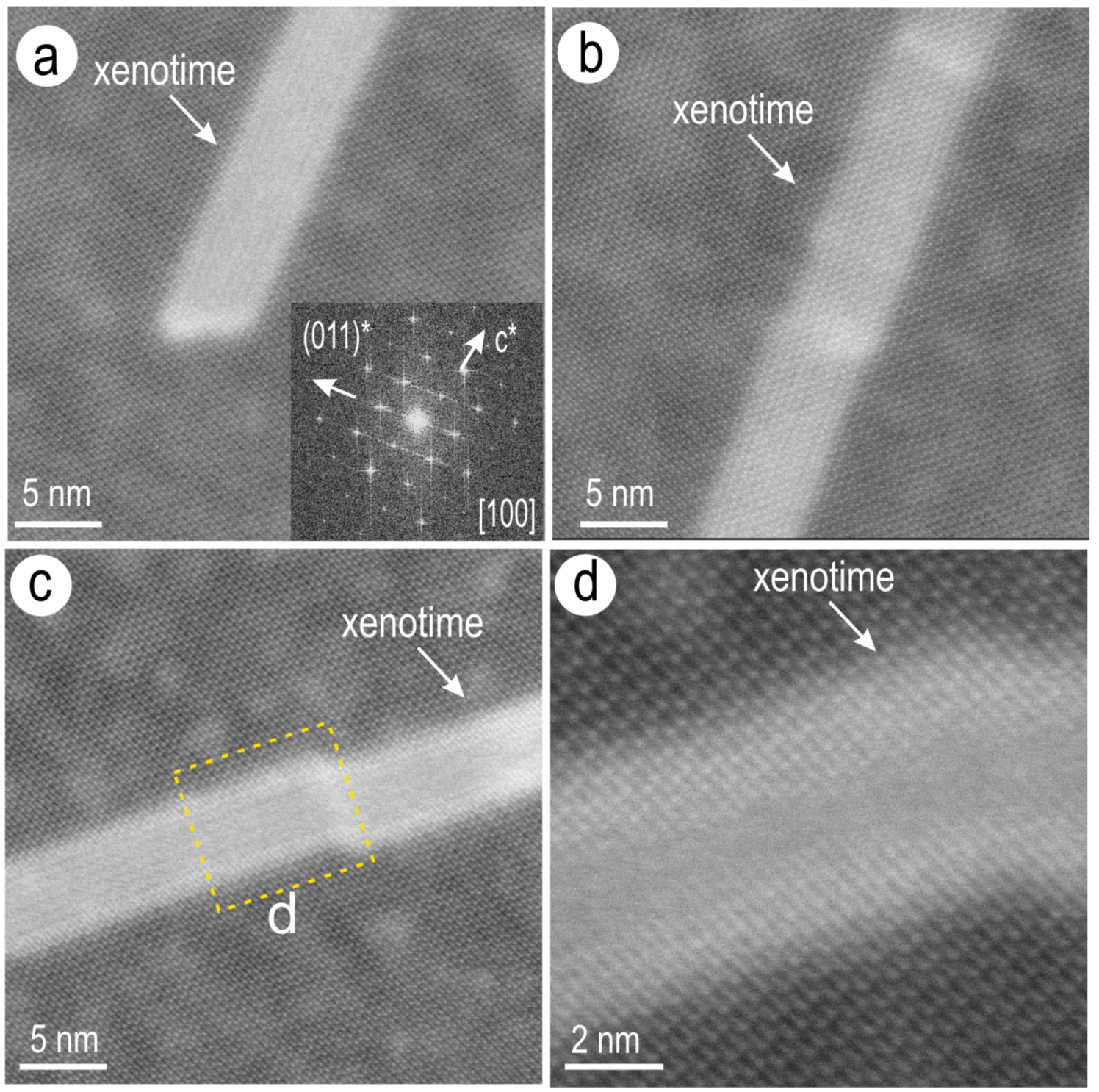
| Point # | CaO | WO3 | MoO3 | Total | Ca | W | Mo | Total | Sch | Pow |
|---|---|---|---|---|---|---|---|---|---|---|
| wt.% | wt.% | wt.% | wt.% | apfu | apfu | apfu | apfu | %.mol | %.mol | |
| Unzoned/weakly zoned W-rich domains (n = 9) | ||||||||||
| Minimum | 20.0 | 70.9 | 2.70 | 97.9 | 1.006 | 0.861 | 0.053 | 0.992 | 86.5 | 13.5 |
| Maximum | 20.4 | 77.3 | 6.86 | 100.0 | 1.025 | 0.944 | 0.134 | 0.998 | 94.6 | 5.4 |
| Mean | 20.2 | 74.0 | 4.88 | 99.0 | 1.014 | 0.899 | 0.096 | 0.995 | 90.4 | 9.6 |
| SD | 0.1 | 2.1 | 1.51 | 0.7 | 0.006 | 0.030 | 0.029 | 0.002 | 2.9 | 2.9 |
| Patterned Mo-rich domains spanning ~Sch20-80Pow20-80 (n = 30) | ||||||||||
| Minimum | 21.2 | 21.4 | 14.5 | 97.1 | 0.984 | 0.201 | 0.270 | 0.996 | 20.4 | 20.1 |
| Maximum | 25.8 | 63.2 | 52.4 | 101.4 | 1.013 | 0.727 | 0.798 | 1.005 | 79.9 | 79.6 |
| Mean | 23.5 | 41.7 | 34.5 | 99.7 | 0.997 | 0.434 | 0.566 | 1.001 | 45.4 | 54.6 |
| SD | 1.2 | 10.9 | 9.9 | 0.8 | 0.007 | 0.136 | 0.137 | 0.002 | 14.5 | 14.5 |
| Oscillatory-zoned grain in Mo-rich domains (FIB cut; foil #1), in order of increasing Pow component | ||||||||||
| 1 | 20.8 | 68.3 | 10.0 | 99.2 | 1.014 | 0.804 | 0.192 | 0.995 | 80.8 | 19.2 |
| 2 | 21.0 | 63.7 | 13.9 | 98.5 | 1.004 | 0.737 | 0.261 | 0.999 | 73.9 | 26.1 |
| 3 | 21.3 | 61.5 | 15.2 | 98.0 | 1.014 | 0.710 | 0.285 | 0.995 | 71.4 | 28.6 |
| 4 | 21.5 | 61.3 | 16.0 | 98.7 | 1.013 | 0.700 | 0.296 | 0.996 | 70.3 | 29.7 |
| 5 | 21.3 | 61.8 | 15.5 | 98.7 | 1.010 | 0.708 | 0.289 | 0.997 | 71.0 | 29.0 |
| 6 | 21.3 | 61.0 | 15.8 | 98.1 | 1.012 | 0.701 | 0.295 | 0.996 | 70.3 | 29.7 |
| 7 | 21.6 | 60.0 | 17.5 | 99.1 | 1.007 | 0.677 | 0.320 | 0.998 | 67.9 | 32.1 |
| 8 | 22.1 | 57.1 | 20.4 | 99.5 | 1.009 | 0.631 | 0.366 | 0.997 | 63.3 | 36.7 |
| 9 | 22.0 | 55.2 | 22.6 | 99.8 | 0.995 | 0.602 | 0.399 | 1.002 | 60.1 | 39.9 |
| 10 | 22.2 | 53.1 | 23.3 | 98.5 | 1.006 | 0.583 | 0.414 | 0.998 | 58.5 | 41.5 |
| Ti | Fe | As | Sr | Nb | Mo | La | Ce | Pr | Nd | Sm | Eu | Gd | Tb | Dy | Y | Ho | Er | Tm | Yb | Lu | ΣREY | W | |
|---|---|---|---|---|---|---|---|---|---|---|---|---|---|---|---|---|---|---|---|---|---|---|---|
| Scheelite-dominant (n = 12) | |||||||||||||||||||||||
| Mean | 0.67 | 14 | 13 | 172 | 3.9 | 19,875 | 4.6 | 13 | 2.4 | 14 | 3.1 | 0.49 | 2.1 | 0.16 | 0.53 | 1.3 | 0.07 | 0.10 | 0.01 | 0.04 | 0.01 | 42 | 626,727 |
| SD | 0.20 | 3.7 | 6.3 | 47 | 1.2 | 8268 | 2.2 | 6.4 | 1.1 | 6.7 | 1.2 | 0.07 | 0.86 | 0.07 | 0.24 | 0.66 | 0.04 | 0.06 | 0.00 | 0.01 | 0.00 | 19 | 21,550 |
| Maximum | 1.1 | 19 | 23 | 282 | 6.2 | 29,485 | 8.3 | 24 | 4.2 | 25 | 5.2 | 0.61 | 3.7 | 0.31 | 1.0 | 2.8 | 0.16 | 0.25 | 0.02 | 0.06 | 0.01 | 76 | 658,904 |
| Minimum | <mdl | 8.0 | 6.4 | 124 | 2.7 | 5673 | 1.4 | 4.4 | 0.81 | 3.6 | 0.90 | 0.31 | 0.63 | 0.07 | 0.22 | 0.42 | 0.02 | 0.03 | <mdl | <mdl | <mdl | 16 | 597,184 |
| Powellite-dominant (n = 9) | |||||||||||||||||||||||
| Mean | 2.2 | 15 | 26 | 133 | 4.4 | 94,866 | 13 | 34 | 5.5 | 27 | 3.8 | 0.38 | 1.9 | 0.12 | 0.39 | 0.87 | 0.04 | 0.08 | 0.01 | 0.03 | 0.01 | 87 | 465,453 |
| SD | 0.36 | 5.2 | 6.5 | 19 | 0.79 | 11,747 | 2.3 | 6.1 | 1.0 | 5.0 | 0.70 | 0.07 | 0.47 | 0.04 | 0.11 | 0.31 | 0.02 | 0.03 | 0.00 | 0.01 | 0.00 | 16 | 21,122 |
| Maximum | 2.6 | 21 | 37 | 167 | 5.3 | 109,489 | 16 | 44 | 7.1 | 36 | 5.0 | 0.46 | 2.8 | 0.20 | 0.55 | 1.5 | 0.07 | 0.13 | 0.01 | 0.04 | 0.01 | 114 | 491,828 |
| Minimum | 1.5 | 8.0 | 18 | 106 | 3.4 | 74,484 | 10 | 26 | 4.2 | 21 | 2.8 | 0.23 | 1.3 | 0.08 | 0.25 | 0.59 | 0.02 | 0.04 | <mdl | <mdl | <mdl | 66 | 430,934 |
| Intermediate scheelite-powellite (n = 10) | |||||||||||||||||||||||
| Mean | 1.3 | 17 | 17 | 148 | 4.5 | 43,709 | 7.3 | 21 | 3.6 | 20 | 3.8 | 0.50 | 2.5 | 0.17 | 0.62 | 1.5 | 0.07 | 0.14 | 0.01 | 0.04 | 0.01 | 61 | 564,895 |
| SD | 0.25 | 2.9 | 3.4 | 27 | 1.1 | 9159 | 1.9 | 5.5 | 0.73 | 3.7 | 0.92 | 0.07 | 0.92 | 0.07 | 0.24 | 0.51 | 0.03 | 0.05 | 0.00 | 0.02 | 0.00 | 14 | 33,321 |
| Maximum | 1.5 | 22 | 21 | 194 | 6.4 | 56,319 | 12 | 35 | 5.3 | 27 | 5.5 | 0.63 | 4.3 | 0.29 | 1.1 | 2.6 | 0.14 | 0.23 | 0.02 | 0.08 | 0.01 | 93 | 609,128 |
| Minimum | 0.68 | 14 | 11 | 125 | 3.0 | 30,518 | 5.3 | 16 | 2.8 | 15 | 2.7 | 0.40 | 1.3 | 0.09 | 0.37 | 0.81 | 0.04 | 0.06 | 0.01 | <mdl | 0.01 | 47 | 490,079 |
© 2019 by the authors. Licensee MDPI, Basel, Switzerland. This article is an open access article distributed under the terms and conditions of the Creative Commons Attribution (CC BY) license (http://creativecommons.org/licenses/by/4.0/).
Share and Cite
Xu, J.; Ciobanu, C.L.; Cook, N.J.; Slattery, A. Crystals from the Powellite-Scheelite Series at the Nanoscale: A Case Study from the Zhibula Cu Skarn, Gangdese Belt, Tibet. Minerals 2019, 9, 340. https://doi.org/10.3390/min9060340
Xu J, Ciobanu CL, Cook NJ, Slattery A. Crystals from the Powellite-Scheelite Series at the Nanoscale: A Case Study from the Zhibula Cu Skarn, Gangdese Belt, Tibet. Minerals. 2019; 9(6):340. https://doi.org/10.3390/min9060340
Chicago/Turabian StyleXu, Jing, Cristiana L. Ciobanu, Nigel J. Cook, and Ashley Slattery. 2019. "Crystals from the Powellite-Scheelite Series at the Nanoscale: A Case Study from the Zhibula Cu Skarn, Gangdese Belt, Tibet" Minerals 9, no. 6: 340. https://doi.org/10.3390/min9060340





